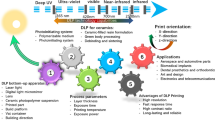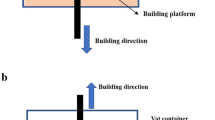Abstract
Traditional fabrication methods of architectural ceramics seek to minimize plastic deformation during wet-processing by prioritizing sectional consistency. Adapting sectional thickness is critical for improving material performance to address localized functional requirements. Functionally Graded Additive Manufacturing (FGAM) enables a design-to-production process where sectional profiles can be designed to achieve targeted performance characteristics. This research utilizes FGAM with Liquid Deposition Modelling (LDM) to prioritize sectional performance over form generation. Functionally graded 3D printed ceramic screens are produced for decorative lighting applications. Custom tool path generation is implemented to create modelling techniques that capitalize on the viscoelastic properties of clay. The prototypes obstruct, reflect, and transmit light across their component sections to grade brightness and illumination. This paper outlines the methods involved in altering plastic deformation during the wet-processing of porous clay structures and the corresponding light-scattering behaviour of their ceramic counterparts. The light screens are organized by the resolution of porosity within each series of prototypes. In the 'Small' typology, deformation is utilized at the scale of a single print layer to form a dense multi-layered sectional condition that disperses light evenly. In the 'Medium' typology, deformation is compounded over multiple layers to form directional light apertures. In the 'Large' typology, extrusion variation is introduced to exaggerate deformation and generate multi-directional light scattering.














Similar content being viewed by others
Notes
Ibid.
Ibid.
References
Ochoa I (2021) Grading light: utilizing plastic deformation to functionally grade ceramic light screens. (M.Arch) University of Waterloo. http://hdl.handle.net/10012/17807
Bechthold M, Kane A, King N (2015) Ceramic material systems. Walter de Gruyter GmbH, Basel/Berlin/Boston
Clarke-Hicks J (2021) Grading light: utilizing plastic deformation to functionally grade ceramic light screens. (M.Arch) University of Waterloo. http://hdl.handle.net/10012/17808
Gürsoy B (2018) From Control to Uncertainty in 3D Printing with Clay. eCAADe 2:21-29. http://papers.cumincad.org/data/works/att/ecaade2018_104.pdf
Gürsoy B (2018) From Control to Uncertainty in 3D Printing with Clay. eCAADe 2:21-29. http://papers.cumincad.org/data/works/att/ecaade2018_104.pdf
Oxman N, Keating S, Tsai E (2011) Functionally graded rapid prototyping. In: da Silva Bartolo PJ (ed) Innovative developments in virtual and physical prototyping. Taylor & Francis Group, London, pp 483–489. https://doi.org/10.1201/b11341-78
Mahamood R, Akinlabi E (2017) Introduction. In: Bergmann C (ed) Functionally graded materials. Springer, Cham, pp 1–8. https://doi.org/10.1007/978-3-319-53756-6
Ahn S, Montero M, Odell D, Roundy S, Wright P (2002) Anisotropic material properties of fused deposition modelling ABS. Rapid Prototyp J 8:248–257. https://doi.org/10.1108/13552540210441166
Shi J, Cho Y, Taylor M, Correa D (2019) Guiding instability: a craft-based approach for modular 3D printed clay masonry screen units. Blucher Design Proceedings 37 Education and Research in Computer Aided Architectural Design in Europe and XXIII Iberoamerican Society of Digital Graphics 1:477–484
Rael R, San Fratello V (2018) Printing architecture. Princeton Architectural Press, New York, NY
Garcia Cuervas D, Pugliese G (2020) Advanced 3D printing with grasshopper: clay and FDM. Independently published
AlOthman S, Im H, Jung F, Bechthold M (2019) Spatial print trajectory: controlling material behaviour with print speed, feed rate, and complex print path. In: Wilmann J, Block P, Hutter M, Byrne K, Schork T (eds) ROBARCH 2018. Springer, Cham. https://doi.org/10.1007/978-3-319-92294-2_13
Ko M, Shin D, Ahn H, Park H (2019) Informed ceramics: multi-axis clay 3D printing on freeform molds. In: Wilmann J, Block P, Hutter M, Byrne K, Schork T (eds) ROBARCH 2018. Springer, Cham. https://doi.org/10.1007/978-3-319-92294-2_23
Dunn K, O’Connor DW, Niemela M, Ulacco G (2016) Free form clay deposition in custom generated molds: producing sustainable fabrication processes. In: Reinhardt D, Saunders R, Burry J (eds) ROBARCH2016. Springer, Cham. https://doi.org/10.1007/978-3-319-26378-6_25
Gourdoukis D (2015) Digital craftsmanship: from the arts and crafts to digital fabrication. Issn 2309–0103 2 4:43–54
Rosenwasser D, Mantell S, Sabin J (2017) Clay non-wovens: robotic fabrication and digital ceramics. Acadia 2017 Disciplines & Disruption Proceedings of the 37th Annual Conference of the Association for Computer Aided Design in Architecture 37:503–511
Acknowledgements
The work presented in this paper builds on research initiated at the University of Waterloo School of Architecture by Adjunct Professors Isabel Ochoa and James Clarke-Hicks as part of their Master’s thesis, supervised by Associate Professor David Correa. This paper is part of Isabel Ochoa and James Clarke-Hicks’ larger ongoing body of work entitled ‘Grading Light.’ ‘Grading Light’ explores how designing custom digital tool paths, not otherwise possible through slicer software, can capitalize on the way that print layers deform to create porous geometries that alter light-scattering behaviour.
Author information
Authors and Affiliations
Corresponding author
Ethics declarations
Conflict of interest
The authors declare that they have no conflict of interest.
Additional information
This manuscript is to be considered for the special issue on "Intelligent Construction and Automation: Challenges and Emerging Technologies".
Rights and permissions
Springer Nature or its licensor (e.g. a society or other partner) holds exclusive rights to this article under a publishing agreement with the author(s) or other rightsholder(s); author self-archiving of the accepted manuscript version of this article is solely governed by the terms of such publishing agreement and applicable law.
About this article
Cite this article
Clarke-Hicks, J., Ochoa, I. & Correa, D. Harnessing plastic deformation in porous 3D printed ceramic light screens. Archit. Struct. Constr. 3, 193–204 (2023). https://doi.org/10.1007/s44150-022-00079-0
Received:
Accepted:
Published:
Issue Date:
DOI: https://doi.org/10.1007/s44150-022-00079-0




